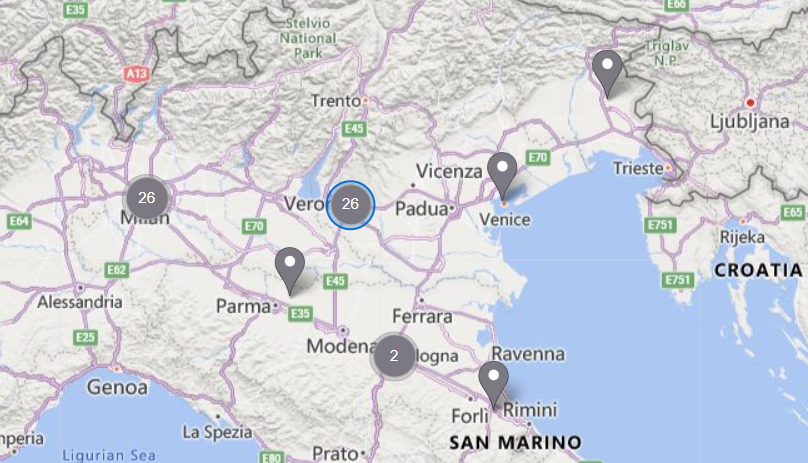Explorer
The Explorer section allows to manage and configure any domains and the connection of any related devices.
Domain view
- Search for a resource
- Create a folder
- Add a local or remote device
- Create a user account
- Create a firewall policy
- Import a firewall policy
- Associate a firewall policy
- Create a group
- Configure permissions
- A domain pane on the left.
- A permissions/information pane on the right.
The main elements included in the are described below:
-
Domain pane: The left pane of this web page shows a hierarchical folders tree containing the remote devices registered to a specific domain.
The domain tree view can be freely customized by the user. The UBIQUITY Manager supports the creation of folders and sub-folders nested as needed. This is especially useful if you want to create different access rules depending on users.
-
Permissions/information pane: By selecting each folder or device, the right pane of the same web page shows information related to the folder or the device respectively, such as connection details or for example: Permissions, Licenses, Firewall and Routing Rules.
Note:You can assign permissions to entire folders or single devices. The devices located in each folder inherit the same permissions as the parent folder. Assigning permissions to a single device allows to specifically select the granted permissions, while this choice is not possible whenever permissions are inherited.
Note: See Domain user permissions for further information on this subject.Note: When hovering on an IP address located in the device information pane, a copy icon appears. This icon allows to easily copy IP addresses. -
Once you have selected a device, right on top of this pane two blue buttons display:
- The Interactive Access (Web Only) or Interactive Access (Tools) button allows to manage the connection with the selected device.
Note: The Interactive Access (Web Only) feature does not require UBIQUITY Tools installation. In this way, you can connect to the remote desktop of the selected device from any device, including smartphones or tablets.Note: See UBIQUITY Manager Tools for further information on this subject.
- The VPN button allows to establish a VPN connection between the UBIQUITY Manager and the selected device.
Note: See (Interactive Access) Connection for further information on this subject.
- The Interactive Access (Web Only) or Interactive Access (Tools) button allows to manage the connection with the selected device.
- Online devices toggle switch:
It allows to filter the domain devices, showing only any currently online devices listed in the domain pane.
- Assistance required toggle switch:
It filters the devices for which an assistance request has been submitted.
- Refresh button:
It refreshes the webpage with the current configurations once these have been saved.
- Permissions pane: It is located on the right pane and allows to add or remove users or groups from the list and grant them specific permissions.
- Add resources: (circled plus icon) It opens a context menu that includes a set of operations.
Note: See UBIQUITY Manager overview and related entities for further information on this subject.
Devices view
The section includes a table that shows all the devices registered to a specific domain and the related information listed in the columns nearby.
The information provided are:
| Column Title | Description |
|
Name |
The device name. |
|
Status |
The status of the runtime connection with the server. |
|
Assistance Request |
Date and time of any open assistance request. |
|
VPN reachable IP |
Device IP reachable through VPN. |
|
Path |
Folders path where the device is stored within the UBIQUITY Manager, in the Domain view section. |
|
Device IP address |
The network interface IP address on the device. |
|
Public IP address |
The device public IP address. |
|
MAC addresses |
The device MAC address or addresses. |
|
UBIQUITY Runtime Version |
The Runtime software version running on the device. |
|
Update status |
The software update status of the Runtime or firmware update. |
|
System family |
The model of the remote device is automatically detected. If not, Generic device will appear. |
|
Operating system |
The operating system of the remote device. |
|
CPU architecture |
The device CPU architecture. |
|
Last login time |
The last remote access login time. |
|
Last logout time |
The last remote access logout time. |
|
Domain registration |
The date and time of the device registration to the domain. |
|
Licenses |
The Runtime license type. |
|
Serial numbers |
The license serial number. |
Also this section includes the following elements located at the top of the screen to narrow your device search:
- Online devices toggle switch:
It allows to filter the domain devices, showing only any currently online devices listed in the domain pane.
- Assistance required toggle switch:
It filters the devices for which an assistance request has been submitted.
- Refresh button:
It refreshes the webpage with the current configurations once these have been saved.
Map view
When you select a pushpin, its border changes to blue and a drop down menu located at the top of the map lists the associated devices in alphabetical order, showing online devices first. The pane on the right shows detailed information about the device location, IP address and allows further settings. You can manually enter a device location, so it will be displayed on the map.
To enter or edit the location of a single device, select it in either the and then edit the device settings to update the Location .

